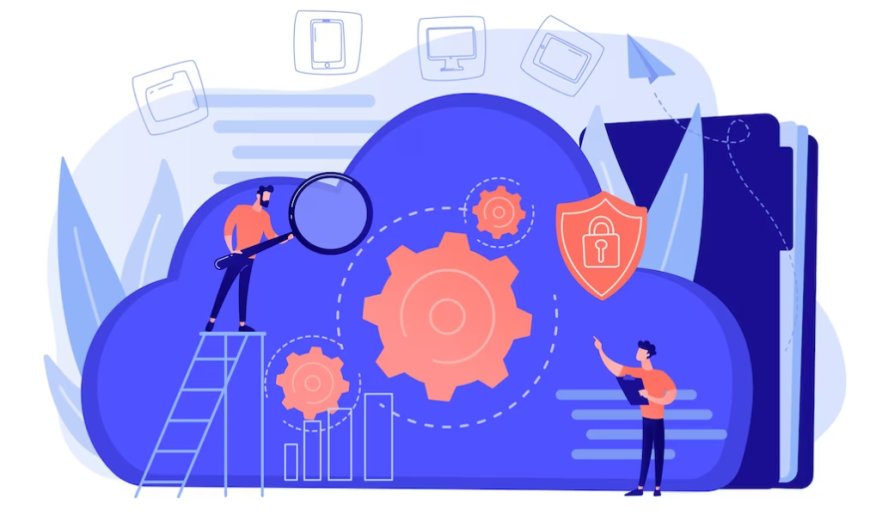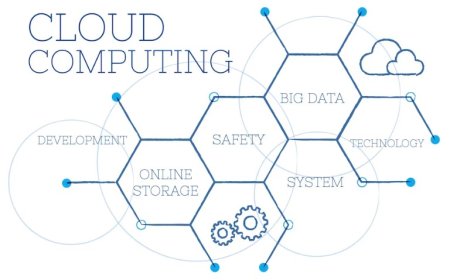The Scope Of Cloud Computing
Explore the vast scope of cloud computing, from its benefits to its impact on businesses. Discover key trends and challenges in the cloud industry. Stay informed about the evolving landscape of cloud technology.

Cloud computing, a transformative technology, revolutionizes how businesses and individuals store, access, and manage data and applications. It involves utilizing a network of remote servers hosted on the internet to store, manage, and process data, rather than relying on a local server or a personal computer. This shift in computing paradigm holds immense significance in today's technology landscape, offering unprecedented scalability, flexibility, and cost-efficiency to users across various industries and sectors. As a result, cloud computing has become an integral component of modern IT infrastructure and is instrumental in driving innovation and efficiency in a wide range of applications.
Historical Evolution
The roots of cloud computing can be traced back to the early 1960s, with visionary thinkers like J.C.R. Licklider who envisioned a future of interactive computing. Licklider's concept of an "Intergalactic Computer Network" laid the groundwork for what we now know as the Internet. Additionally, the idea of remote computing, where users could access powerful mainframe computers from terminals, was explored in projects like MIT's Compatible Time-Sharing System (CTSS). These early concepts were pivotal in shaping the foundation of cloud computing.
The term "cloud computing" gained prominence in the 1990s with the rise of internet-based services. Companies like Salesforce pioneered the concept of delivering software applications over the internet, a precursor to today's Software as a Service (SaaS) model. As internet speeds and infrastructure improved, tech giants such as Amazon, Google, and Microsoft began to invest heavily in cloud infrastructure. This led to the creation of Amazon Web Services (AWS), Google Cloud Platform (GCP), and Microsoft Azure, which revolutionized the way businesses could leverage computing resources. These developments marked the rapid emergence and subsequent explosion of cloud computing as a dominant force in the modern technology landscape.
Key Components of Cloud Computing
Infrastructure as a Service (IaaS)
Infrastructure as a Service, or IaaS, is a fundamental pillar of cloud computing. It provides users with virtualized computing resources over the internet. With IaaS, businesses can access and manage virtualized hardware resources such as servers, storage, and networking infrastructure. This model offers scalability, flexibility, and cost-efficiency as users can scale their infrastructure up or down according to their needs without the burden of physical hardware management.
Platform as a Service (PaaS)
Platform as a Service, or PaaS, takes cloud computing a step further by offering a development and deployment environment in addition to infrastructure. PaaS providers deliver a platform that includes tools, frameworks, and services for developers to build, test, and deploy applications without worrying about the underlying infrastructure. It streamlines application development, making it faster and more accessible, while also providing scalability and reduced operational overhead.
Software as a Service (SaaS)
Software as a Service, or SaaS, is a cloud computing model that provides software applications over the internet on a subscription basis. Users can access and use these applications through web browsers without needing to install or maintain software locally. Popular examples of SaaS include email services like Gmail, collaboration tools like Microsoft 365, and customer relationship management (CRM) systems like Salesforce. SaaS offers convenience, accessibility, and automatic updates to users.
Function as a Service (FaaS)
Function as a Service, or FaaS, is a serverless computing model where developers can write and execute individual functions or pieces of code in response to specific events or triggers. FaaS abstracts infrastructure management entirely, allowing developers to focus solely on their code's functionality. It is particularly useful for building highly scalable and event-driven applications, such as IoT systems, chatbots, and data processing tasks. FaaS offerings include AWS Lambda and Azure Functions.
These key components of cloud computing collectively empower businesses and individuals to harness the benefits of the cloud, from infrastructure and development to software applications and event-driven functions, enabling agility, scalability, and innovation in the digital age.
Deployment Models
-
Public Cloud: The public cloud is a cloud computing model where cloud resources, including servers, storage, and applications, are owned and operated by third-party cloud service providers. These providers make resources available to the general public over the Internet. Public cloud services are scalable and cost-effective, making them suitable for startups, small businesses, and organizations with fluctuating workloads. Examples of public cloud providers include AWS, Azure, and Google Cloud.
-
Private Cloud: A private cloud is a cloud infrastructure dedicated to a single organization. It can be hosted on-premises or by a third-party provider and offers greater control, security, and customization compared to public clouds. Private clouds are favored by enterprises and industries with strict compliance and data privacy requirements, such as finance and healthcare. They provide a dedicated environment for sensitive data and critical applications.
-
Hybrid Cloud: The hybrid cloud combines elements of both public and private clouds, allowing data and applications to be shared between them. Organizations use a hybrid cloud approach to leverage the scalability and cost-effectiveness of the public cloud while retaining the control and security of a private cloud for sensitive data. Hybrid clouds offer flexibility and are ideal for businesses with evolving needs or legacy systems that want to integrate with cloud services.
-
Community Cloud: Community cloud is a deployment model where cloud resources are shared among organizations with similar interests or compliance requirements. These organizations collaborate to create and maintain a shared cloud infrastructure tailored to their specific needs. Community clouds are often used by industries like healthcare, where multiple healthcare providers collaborate on a secure cloud platform to manage patient data while adhering to regulatory standards.
Deployment models in cloud computing offer diverse options to suit the unique requirements and preferences of organizations, ensuring that businesses can find the right cloud solution to meet their specific needs.
Industries and Applications:
Cloud computing has permeated virtually every sector, revolutionizing operations and services across industries.
In business and enterprise solutions, cloud platforms offer scalable resources and flexible infrastructure, enabling organizations to streamline operations, enhance collaboration, and deploy applications with agility.
In healthcare and life sciences, cloud computing facilitates the secure storage and analysis of vast amounts of medical data, enabling advancements in research, personalized medicine, and telehealth services.
The education sector leverages cloud technology to provide scalable e-learning platforms, allowing for remote access to educational resources, fostering collaboration among students and educators, and enhancing the learning experience.
Financial institutions rely on cloud computing for its cost-effective and secure storage solutions, enabling real-time transaction processing, robust data analytics, and compliance with stringent regulatory requirements.
In e-commerce and retail, cloud-based solutions power online marketplaces, providing a seamless shopping experience, robust inventory management, and personalized customer interactions. Additionally, it enables retailers to harness the power of data analytics for targeted marketing campaigns and customer insights.
These are just a few examples of how cloud computing has become a linchpin in various industries, driving innovation, efficiency, and competitive advantage. Its versatility and adaptability continue to unlock new possibilities and transform the way businesses operate across the globe.
Benefits of Cloud Computing
Cloud computing offers a multitude of advantages that have transformed the way organizations operate:
1. Cost-Efficiency: Cloud services eliminate the need for significant upfront investments in hardware and data centers. Businesses can scale resources up or down as needed, paying only for what they use. This cost-effective model lowers operational expenses and promotes financial flexibility.
2. Scalability: Cloud platforms provide on-demand scalability, allowing businesses to easily adjust computing resources to accommodate fluctuations in workload. This agility ensures that systems remain responsive and efficient, even during peak usage periods.
3. Accessibility and Flexibility: Cloud services are accessible from anywhere with an internet connection. This flexibility enables remote work, collaboration, and the ability to access critical data and applications on various devices, promoting productivity.
4. Reliability and Redundancy: Leading cloud providers offer robust infrastructure with redundancy and high availability. This minimizes the risk of downtime, ensuring that services remain accessible, and data is secure and backed up.
5. Automatic Updates and Maintenance: Cloud providers handle routine maintenance, updates, and security patches. This alleviates the burden on IT teams, allowing them to focus on strategic initiatives rather than day-to-day maintenance tasks.
6. Enhanced Security: Cloud providers invest heavily in security measures, often surpassing what many organizations can achieve on their own. They employ advanced encryption, authentication, and monitoring to protect data and applications.
7. Disaster Recovery: Cloud-based disaster recovery solutions offer rapid data backup and recovery capabilities. This ensures business continuity in the event of data loss, hardware failures, or other unforeseen disasters.
8. Global Reach: Cloud services have a global presence, allowing businesses to reach customers and users worldwide. Content delivery networks (CDNs) ensure fast and reliable content distribution across the globe.
9. Environmental Sustainability: Cloud providers focus on energy efficiency and sustainability. By consolidating data centers and optimizing resource usage, they contribute to reduced energy consumption and carbon emissions.
Challenges and Concerns
Cloud computing, while offering numerous advantages, also comes with its fair share of challenges and concerns that organizations need to address:
The storage and processing of sensitive data in the cloud raise concerns about data security and privacy. Ensuring robust encryption, access control, and compliance with data protection regulations is essential.
Different industries and regions have specific compliance requirements. Navigating these regulations, such as GDPR or HIPAA, while using cloud services can be complex and requires careful management.
Cloud services are typically pay-as-you-go, which can lead to unpredictable costs if not properly managed. Organizations need to monitor and optimize their cloud usage to avoid overspending.
Depending heavily on a specific cloud provider's services can lead to vendor lock-in, making it challenging to migrate to another provider or back to on-premises solutions if needed.
Cloud services rely on internet connectivity. Downtime or connectivity issues can disrupt operations, so having backup plans and redundancy is crucial.
Future Trends and Innovations
The future of cloud computing promises exciting advancements and innovations. Edge computing is set to bring processing closer to data sources, reducing latency and enhancing real-time capabilities. Quantum computing's integration into the cloud will open new frontiers in solving complex problems. Artificial intelligence and machine learning will further augment cloud services, making them smarter and more efficient. Sustainability will become a focal point, with green cloud computing practices gaining prominence. Additionally, the rollout of 5G networks will revolutionize the speed and connectivity of cloud services, ushering in a new era of digital possibilities. These trends are poised to shape the future landscape of cloud computing.
Cloud computing has emerged as a transformative force in the realm of technology, offering diverse services and deployment models that cater to a wide range of industries and applications. Its scope encompasses everything from infrastructure to software, fostering innovation and efficiency. As we look to the future, cloud computing continues to evolve, with trends like edge computing, AI integration, and sustainability poised to reshape the landscape. Understanding and harnessing the power of the cloud remains paramount for businesses and individuals seeking to thrive in the ever-expanding digital era.






























































